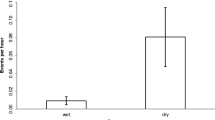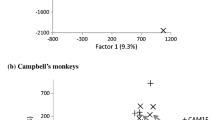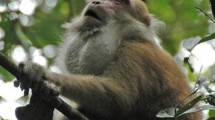Summary
Ecological and behavioral data from long-term field studies of known individuals in two closely related squirrel monkey species (Saimiri oerstedi and S. sciureus) were used to examine hypotheses about the source of variation in female bonding among group-living primates. Social relationships in species which live in cohesive groups are thought to depend on the nature of competition for resources. S. oerstedi and S. sciureus both live in large groups and are subject to intense predation. Direct feeding competition both between and within groups is extremely low in S. oerstedi; in this species female relationships are undifferentiated, no female dominance hierarchy is evident and females disperse from their natal group. S. sciureus also experiences very low levels of between-group competition, but within-group direct competition for resources is frequent; this species demonstrates differentiated female relationships, a female dominance hierarchy, and female philopatry. The correlated ecological and social variables found in these two congeners further minimize the minor effects of phylogenetic differences and emphasize the importance of food distribution in determining social characteristics.
Similar content being viewed by others
References
Boinski S (1986) The ecology of squirrel monkey in Costa Rica. Unpubl PhD thesis. The University of Texas at Austin TX
Boinski S (1987a) Birth synchrony in squirrel monkeys (Saimiri oerstedi): a strategy to reduce neonatal predation. Behav Ecol Sociobiol 21: 393–400
Boinski S (1987b) Mating patterns in squirrel monkeys (Saimiri oerstedi): implications for seasonal sexual dimorphism. Behav Ecol Sociobiol 21:13–21
Boinski S (1987c) Habitat use by squirrel monkeys (Saimiri oerstedi) in Costa Rica. Folia Primatol 49:151–167
Boinski S (1987d) The status of Sairmiri oerstedi citrinellus in Costa Rica. Primate Conserv 8:69–72
Boinski S (1988) Sex differences in the foraging behavior of squirrel monkeys in a seasonal habitat. Behav Ecol Sociobiol 23:177–186
Boinski S (1989) The positional behavior and substrate use of squirrel monkeys: ecological implications. J Hum Evol 18:659–677
Boinski S, Fowler NL (1989) Seasonal patterns in a lowland tropical forest. Biotropica 21:223–233
Busse CD (1976) Chimpanzee predation as a possible factor in the evolution of red colubus monkey social organization. Evolution 31:907–911
Clutton-Brock TH, Harvey PH (1977) Primate ecology and social organization. J Zool Lond 183:1–39
Crook JH (1970) Social organization and environment: aspects of a contemporary social ethology. Anim Behav 18:197–209
Crook JH (1972) Sexual selection, dimorphism and social organization in the primates. In: Campbell BG (ed) Sexual selection and the descent of man. Aldine, Chicago, pp 231–281
DeVore I (1963) A comparison of the ecology and behavior of monkeys and apes. In: Washburn SL (ed) Classification and human evolution. Aldine, Chicago, pp 301–319
Dunbar RIM, Dunbar EP (1976) Contrasts in social structure among black-and-white colobus groups. Anim Behav 24:84–92
Emlen ST, Oring LT (1977) Ecology, sexual selection, and the evolution of mating systems. Science 197:215–223
Hershkovitz P (1984) Taxonomy of squirrel monkeys genus Saimiri (Cebidae, Platyrrhini): a preliminary report with description of a hitherto unnamed form. Am J Primatol 7:155–210
Hinde RA (1983) Primate social relationships: an integrated approach. Blackwell, Oxford
Janson CH, Boinski S (submitted) Morphological versus behavioral adaptations for foraging in generalist primates: the case of the cebines
Jay PC (1965) The common langur of north India. In: DeVore I (ed) Primate behavior. Holt Rinehart & Winston, New York, pp 197–249
Landeau L, Terborgh JW (1986) Oddity and the “confusion effect” in predation. Anim Behav 34:1372–1380
Lazarus J (1979) The early warning function of flocking birds: an experimental study with captive quelea. Anim Behav 27:855–865
Leutenegger W, Kelly JT (1977) Relationship of sexual dimorphism in canine size and body size to social, behavioral, and ecological correlates in anthropoid primates. Primates 18:117–136
Miller RS (1967) Pattern and process in competition. Adv Ecol Res 4:1–74
Mitchell CL (1990) The ecological basis for female social dominance: a behavioral study of the squirrel monkey (Saimiri sciureus) in the wild. PhD thesis, Princeton University
Noordwijk MA van, Schaik CP van (1987) Competition among adult female long-tailed macaques. Anim Behav 36:577–589
Oates JF (1977) The social life of the black-and-white colobus monkey, Colobus guereza. Z Tierpsychol 45:1–60
Schaik CP van (1983) Why are diurnal primates living in groups? Behaviour 87:120–144
Schaik CP van (1989) The ecology of social relationships amongst female primates. In: Standen V, Foley RA (eds) Comparative socioecology: the behavioural ecology of humans and other animals. Blackwell, Oxford, pp 195–218
Schaik CP van, Hooff J van (1983) On the ultimate causes of primate social systems. Behaviour 85:91–117
Schaik CP van, Noordwijk MA van, Warsono B, Sutriono E (1983) Party size and early detection of predators in Sumatran forest primates. Primates 24:211–221
Silk JB (1987) Social behavior in evolutionary perspective. In: Smuts BB, Cheney DL, Seyfarth RM, Wrangham RW, Struhsaker TT (eds) Primate societies. University of Chicago Press, Chicago, pp 318–329
Terborgh J (1983) Five new world primates. Princeton University Press, Princeton
Terborgh J, Janson CH (1986) The socioecology of primate groups. Annu Rev Ecol Syst 17:111–135
Thorington RW (1985) The taxonomy and distribution of squirrel monkeys (Saimiri). In: Rosenblum LA, Coe CL (eds) Handbook of squirrel monkey research. Plenum Press, New York, pp 1–33
Whitten PL (1983) Diet and dominance among female vervets. Am J Primatol 5:139–159
Wrangham RW (1979) On the evolution of ape social systems. Soc Sci Inf 18:335–368
Wrangham RW (1980) An ecological model of female-bonded primate groups. Behaviour 75:262–300
Wrangham RW (1987) The evolution of social structure. In: Smuts BB, Cheney DL, Seyfarth RM, Wrangham RW, Struhsaker TT (eds) Primate societies. University of Chicago Press, Chicago, pp 282–296
Author information
Authors and Affiliations
Additional information
Offprint requests to: S. Boinski
Rights and permissions
About this article
Cite this article
Mitchell, C.L., Boinski, S. & van Schaik, C.P. Competitive regimes and female bonding in two species of squirrel monkeys (Saimiri oerstedi and S. sciureus). Behav Ecol Sociobiol 28, 55–60 (1991). https://doi.org/10.1007/BF00172139
Received:
Accepted:
Issue Date:
DOI: https://doi.org/10.1007/BF00172139




